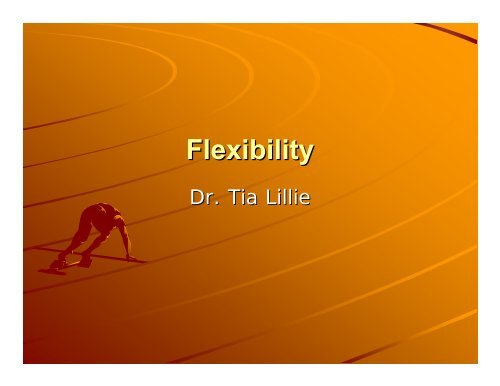Flexibility (pdf)
Flexibility (pdf)
Flexibility (pdf)
Create successful ePaper yourself
Turn your PDF publications into a flip-book with our unique Google optimized e-Paper software.
<strong>Flexibility</strong>Dr. Tia Lillie
<strong>Flexibility</strong> Activity<strong>Flexibility</strong> is animportant butoften neglectedpart of anexercise programThe importanceof flexibility forhealth and well-being becomesmore importantwith ageConcepts of Physical Fitness 12e 2
Benefits of <strong>Flexibility</strong>Decreased riskof back painDecreasedrisk of injuryImprovedathleticperformance
DefinitionsRange of Motion (ROM) – Full motion ofa joint. Extensibility of ligaments, thesurrounding muscles and the tendons thatconnect the musclesLigament – Connects bonesTendons – Connects muscles to bonesHypermobility – Joint loosenessLaxity – Motion of a joint outside normalplane
TerminologyAgonist Muscles – The musclegroup being stretchedAntagonist Muscles – Muscle groupon the opposite side of the limb fromthe muscle group being stretched(biceps is antagonist of triceps)
<strong>Flexibility</strong> and Back PainShort and tightmuscles causepoor posturewhich leads toback pain
<strong>Flexibility</strong> and Back Pain• Long and strongmuscles keep thebody in goodalignment andreduce risk ofback pain
Facts about <strong>Flexibility</strong><strong>Flexibility</strong> is joint specific<strong>Flexibility</strong> is enhanced ifbody is warm
Influence of Age on <strong>Flexibility</strong>FLEXIBILITYFLEXIBILITYPHYSICAL ACTIVITYACTIVITY10 20 30 40 50 60 70AGE (years)
Common MovementsFlexionExtensionAbductionAdductionRotation
Static StretchingStretch slowly untiltensionHold stretch for 10 - 30sec.Relax the muscleIncrease stretch a bitmore(developmental stretch)
Ballistic StretchingMuscles are stretch by the force ofmomentum – bouncing, jerking
Golgi Tendon Organs (GTOs(GTOs)Proprioceptors - located in the tendonsGTOs are activated when the tendonattached to an active muscle is stretched– As tension in the muscle thedischarge of GTOs – Provides a protective mechanism formexcessive tensionWhen heavy load is placed on the muscle,reflexive inhibition by the GTOs cause themuscle to relax
StretchReflexMaintainingstretch for10- 30secondswill allow thestretch reflexto subside andpermit gains.
Methods of StretchingActive Stretching / Active AssistanceAn assist to stretch from an activecontraction of the opposing antagonistmuscleAn example: Calf stretch – the musclesof the shin are contracted to assist inthe stretch of the muscles of the calfSee page 148 for examples
Methods of StretchingPassive Stretching / Passive AssistanceStretch imposed on a muscle with theassistance of a force other than theopposing muscleExample: A partner, another body part orgravity aids you in stretchingSee page 148 for examples
Proprioceptive NeuromuscularFacilitation (PNF)Combines (active and passive)methodsMost effective method forimproving flexibilityPromotes increase in strengthSee page 148 for examples
PNF Stretching Technique(C.R.A.C. Method)Contract agonist isometricallyRelax muscle for a few secondsContract the antagonist for 15secondsRelax
FIT Formula(Static Stretching)F 3 - 7 times per weekI 10% beyond normal length ofmuscleT 10-60 seconds
Areas Needing StretchingHamstringsInner thighCalfHip flexorsLower backChest / shoulders
Stretching PrecautionsDon't force stretch to the point ofpainChoose safe exercisesAvoid overstretching weak musclesUse good technique
Hamstring StretchesBADBADGOODStandingToe TouchBar StretchBack Saver Hamstring Stretch
Shin and Quadriceps StretchesBADGOODGOODStanding StretchShin StretchQuad Stretch
Reference• Corbin, C.B., Welk, , G.J., Corbin, W.R., Welk, , K.A. (2008).Concepts of Physical Fitness: Active Lifestyles forwellness (14th ed.). New York, NY: McGraw-HillPublishers.

















